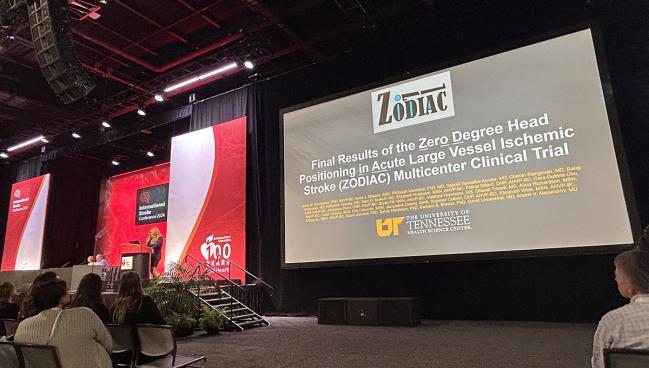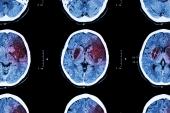ZODIAC: Laying Flat Equals Better Outcomes for Stroke Thrombectomy Candidates
”Zero-degree positioning” may be one of the most important first steps in managing large vessel occlusions, study shows.

PHOENIX, AZ—Placing patients with an acute ischemic stroke caused by a large-vessel occlusion (LVO) flat on their bed as they await mechanical thrombectomy is a simple way to improve short-term outcomes, according to the randomized ZODIAC trial.
Compared with having patients placed at a 30-degree angle, laying them flat markedly reduced early neurological deterioration, defined as an increase of at least 2 points on the NIHSS prior to thrombectomy (2.2% vs 55.3%; P < 0.001), Anne Alexandrov, PhD, RN (University of Tennessee Health Science Center, Memphis), reported here at the International Stroke Conference.
Moreover, the approach was safe, with no cases of symptomatic intracerebral hemorrhage or hospital-acquired pneumonia observed and a lower rate of all-cause death at 90 days compared with a 30-degree angle (4.4% vs 21.7%; P = 0.03).
Laying patients flat “does impart clinical stability and clinical improvement in LVO thrombectomy candidate patients, and we would consider this to be a rescue procedure,” Alexandrov said. “This is certainly not a treatment for stroke. These patients need to go to the lab and be treated.”
But, she added, “use of zero-degree positioning may be one of the most important first steps in managing a large-vessel occlusion patient. When you get that [CT angiography] confirmation, put the head of the bed down. And this is critically important in patients that arrive at a hospital that is not capable of performing thrombectomy because of the inherent delays to treatment.”
Commenting for TCTMD, Louise McCullough, MD, PhD (University of Texas Health Science Center at Houston), said there have been a lot of studies into how perfusion can be enhanced to keep brain tissue viable in patients with acute stroke, but no strategies have been particularly successful.
“I think the thing that makes this a very unique and nice trial is [the strategy is] so easy and it’s so quick and it can be done everywhere,” McCullough said. “So I think the broad applicability of it is really what’s making people interested about it.”
The ZODIAC Trial
Clinical deterioration of patients with acute stroke who were placed with the head raised was first recognized several decades ago, and the phenomenon was eventually coined “positional cerebral ischemia,” Alexandrov said. Since then, small studies have shown that blood flow to the brain can be improved when patients are placed flat in bed. Whether the position of the patient’s head makes a difference for thrombectomy candidates, however, hadn’t been studied before the ZODIAC trial.
This study, conducted at 12 US hospitals, included 92 patients (mean age roughly 66 years) who had an LVO stroke and a treatment plan that included mechanical thrombectomy. While patients were still flat on the CT scanning bed, investigators calculated the initial NIHSS score and administered thrombolytic therapy to those who were eligible. The patients were then randomized immediately to remaining in a zero-degree position or being placed at a 30-degree angle, with those positions maintained until they were taken in for thrombectomy. The final NIHSS score calculation occurred before the patient was moved to the catheterization table.
The primary outcome was early neurological deterioration prior to thrombectomy, with a significant advantage for zero-degree head positioning. The difference between groups worked out to a number needed to harm with 30-degree positioning of just 1.88.
The rate of severe neurological deterioration (at least a 4-point increase in NIHSS score) also favored placing the patient flat in bed (2.2% vs 42.6%; P < 0.001), with a number needed to harm with a seated position of 2.48.
Further exploratory endpoints showed that patients who were kept at a zero-degree angle were more likely than those placed seated to have an improvement in NIHSS score at 24 hours (86.7% vs 60.9%; P = 0.008) and at 7 days or discharge (86.7% vs 67.4%; P = 0.045). That was surprising, Alexandrov said, because thrombectomy was expected to provide similar outcomes in both groups.
By 90 days, functional outcomes according to the modified Rankin Scale (mRS) tended to favor zero-degree positioning, although the differences were not statistically significant.
Some Caution
Though the observed effects on neurological deterioration were “stunningly impressive,” the findings should be interpreted with caution, McCullough indicated, pointing to the relatively small size of the trial and the types of patients who were excluded. “For a lot of people with aphasia or dysarthria, probably that still isn’t the right thing to do,” she said, referring to placing patients flat on their beds. Moreover, she said, confirmation in a larger trial would provide more confidence that zero-degree positioning is the right approach.
Still, even for patients who present directly to a comprehensive stroke center, there will be at least some delay to thrombectomy, McCullough said. “This very simple measure that you can use to enhance blood flow—presumably that’s the way it’s working, as kind of a bridge to thrombectomy—seems to make physiological sense.”
Functional outcomes at 90 days were not significantly different between groups, but McCullough noted that the mRS is a “pretty crude” assessment. Thus, she said, more-detailed assessments likely would show a benefit for zero-degree positioning at the later time points.
“I think it’s pretty clear,” McCullough said. “I’m going to be a lot more aware when I see my patients to lay them flat, especially as they’re awaiting thrombectomy. And especially if they don’t have a reason to not lay them flat, like congestive heart failure or an aspiration.”
To TCTMD, Larry Goldstein, MD (University of Kentucky, Lexington), predicted that the results would encourage physicians to start laying patients flat. “It certainly wasn’t harmful and from the trial, it appears to be helpful,” he said. “It’s very simple, very straightforward, and makes sense.”
Todd Neale is the Associate News Editor for TCTMD and a Senior Medical Journalist. He got his start in journalism at …
Read Full BioSources
Alexandrov AW. Final results of the zero degree head positioning in acute large vessel ischemic stroke (ZODIAC) multicenter clinical trial. Presented at: ISC 2024. February 7, 2023. Phoenix, AZ.
Disclosures
- Alexandrov, her team, and all sub-investigators are supported by grant funding for ZODIAC from the National Institute of Nursing Research.





Comments